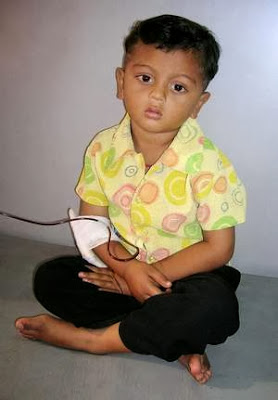to find out whether the fetus has thalassemia and how severe it might be. The following tests may be done:
Chorionic villus sampling - a piece of the placenta
is taken out and checked in the laboratory. This is usually done at the
end of the first trimester, around the 11th week of pregnancy.
Amniocentesis - a sample of amniotic fluid is
taken. This usually occurs during the 16th week of pregnancy. Amniotic
fluid is a clear, slightly yellowish liquid that surrounds the fetus.
SIFAT's Disease ATLAS
Wednesday, October 9, 2013
Thalassemia has an autosomal recessive pattern of inheritance
Both α and β thalassemias are often inherited in an autosomal recessive fashion, although this is not always the case. Cases of dominantly
inherited α and β thalassemias have been reported, the first of which
was in an Irish family with two deletions of 4 and 11 bp in exon 3
interrupted by an insertion of 5 bp in the β-globin gene. For the autosomal recessive
forms of the disease, both parents must be carriers in order for a
child to be affected. If both parents carry a hemoglobinopathy trait,
there is a 25% risk with each pregnancy for an affected child. Genetic counseling and genetic testing is recommended for families that carry a thalassemia trait.
There are an estimated 60-80 million people in the world carrying the beta thalassemia trait alone. This is a very rough estimate; the actual number of thalassemia major patients is unknown due to the prevalence of thalassemia in less developed countries.Countries such as India and Pakistan are seeing a large increase of thalassemia patients due to lack of genetic counseling and screening. There is growing concern that thalassemia may become a very serious problem in the next 50 years, one that will burden the world's blood bank supplies and the health system in general. There are an estimated 1,001 people living with thalassemia major in the United States and an unknown number of carriers. Because of the prevalence of the disease in countries with little
knowledge of thalassemia, access to proper treatment and diagnosis can
be difficult.
There are an estimated 60-80 million people in the world carrying the beta thalassemia trait alone. This is a very rough estimate; the actual number of thalassemia major patients is unknown due to the prevalence of thalassemia in less developed countries.Countries such as India and Pakistan are seeing a large increase of thalassemia patients due to lack of genetic counseling and screening. There is growing concern that thalassemia may become a very serious problem in the next 50 years, one that will burden the world's blood bank supplies and the health system in general. There are an estimated 1,001 people living with thalassemia major in the United States and an unknown number of carriers. Because of the prevalence of the disease in countries with little
FACES OF PATIENTS IN THALASSEMIA
\
Thalassemia is a group of inherited blood disorders that affect the body's ability to produce hemoglobin and red blood cells - patients have a lower-than-normal number of red blood cells in their bodies and too little hemoglobin. In many cases the red blood cells are too small.
Signs And Symptoms Of Beta Thalassemia
The majority of infants with beta thalassemia will not have symptoms until they reach six months, because they start off with a different type of hemoglobin called fetal hemoglobin. After the age of six months "normal" hemoglobin starts replacing the fetal one. People with thalassemia mainly have anemia-like symptoms.- Jaundice
- Fatigue
- Pale skin
- Cold hands and feet
- Shortness of breath
- Poor feeding
- Delayed growth
- Skeletal deformities - in some cases as the body tries to produce more bone marrow
- Too much iron - the body will try to absorb more iron to compensate. Iron may also accumulate from blood transfusions. Excessive iron can harm the spleen,heart and liver
- Greater susceptibility to infections
- Delayed puberty
Signs And Symptoms Of Alpha Thalassemia
The majority of children with hemoglobin H are generally healthy. Symptoms will range from mild to moderate anemia.- Fatigue
- Drowsiness
- Chest pain
- Pale skin
- Cold hands and feet
- Headaches
- Dizziness and feeling faint
- Shortness of breath
Radiological findings of Scurvy ( vit C deficiency)
Radiological findings of Scurvy:
1. white lines of frankel's and suboeriosteal elevation
2.Wimburger's ring sign: ringing of epiphysis -denser white line of calcification encircling the osteoporotic epiphyses in scurvy.
3.Ground glass appearance of diaphysis.
4. pencil thining of cortex
5.Pelkan's Spur: corner spur
sign symptoms of scurvy:
Vitamin C is essential for collagen synthesis. Defective collagen compromises skin, joint, bone, and vascular integrity.
1. white lines of frankel's and suboeriosteal elevation
2.Wimburger's ring sign: ringing of epiphysis -denser white line of calcification encircling the osteoporotic epiphyses in scurvy.
3.Ground glass appearance of diaphysis.
4. pencil thining of cortex
5.Pelkan's Spur: corner spur
sign symptoms of scurvy:
 | |
| ecchymosis in scurvy patient |
 | |
| gum bleeding |
Pathophysiology of scurvy:
A lack of dietary vitamin C (ascorbic acid) may be related to inadequate food intake, the destruction of vitamin C in food caused by cooking and canning, or the absence of fresh fruit in the diet.Vitamin C is essential for collagen synthesis. Defective collagen compromises skin, joint, bone, and vascular integrity.
Subscribe to:
Posts (Atom)











